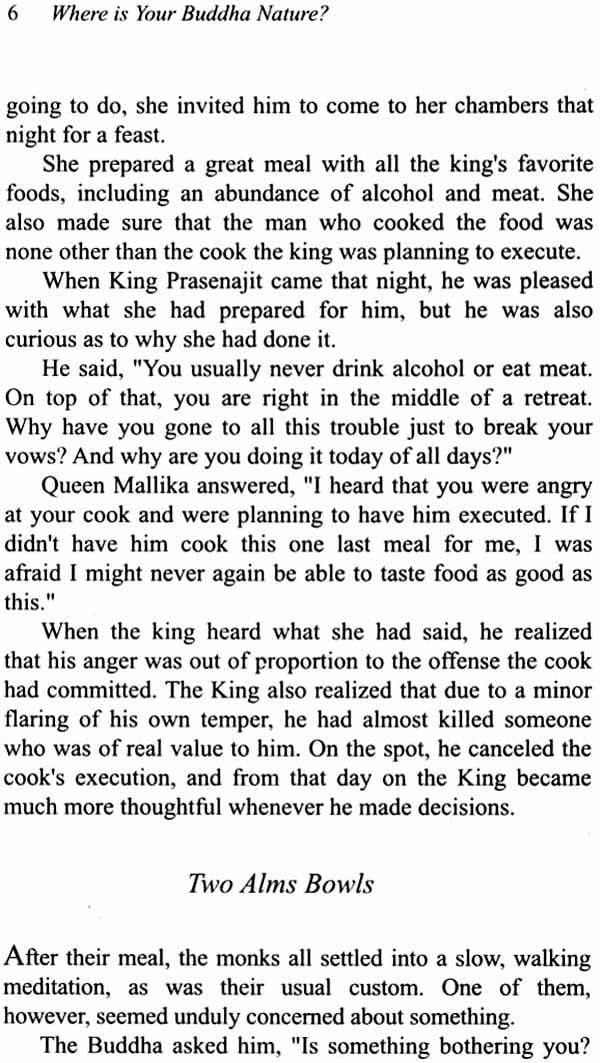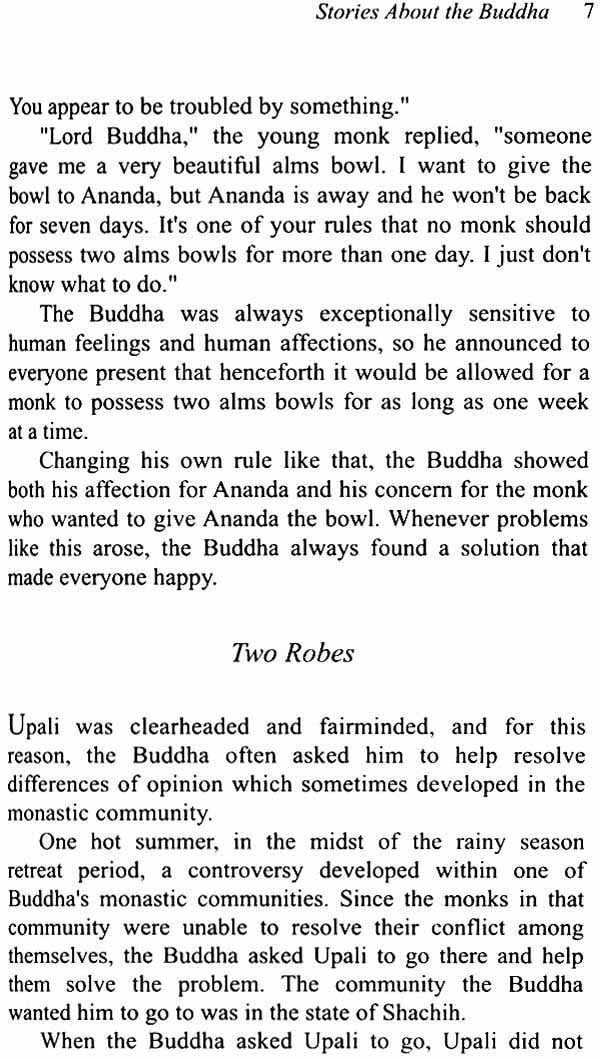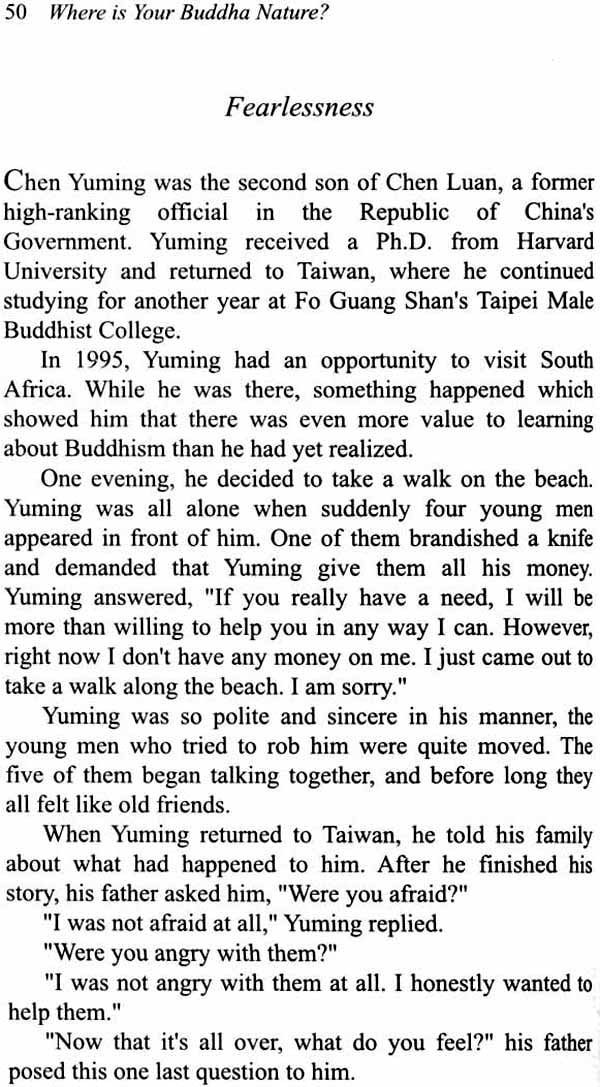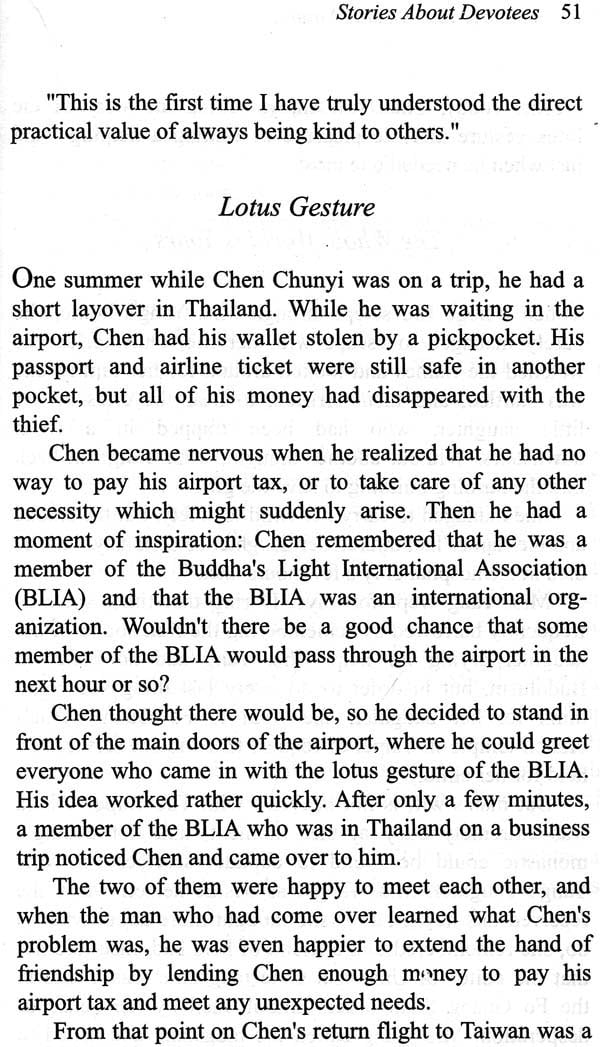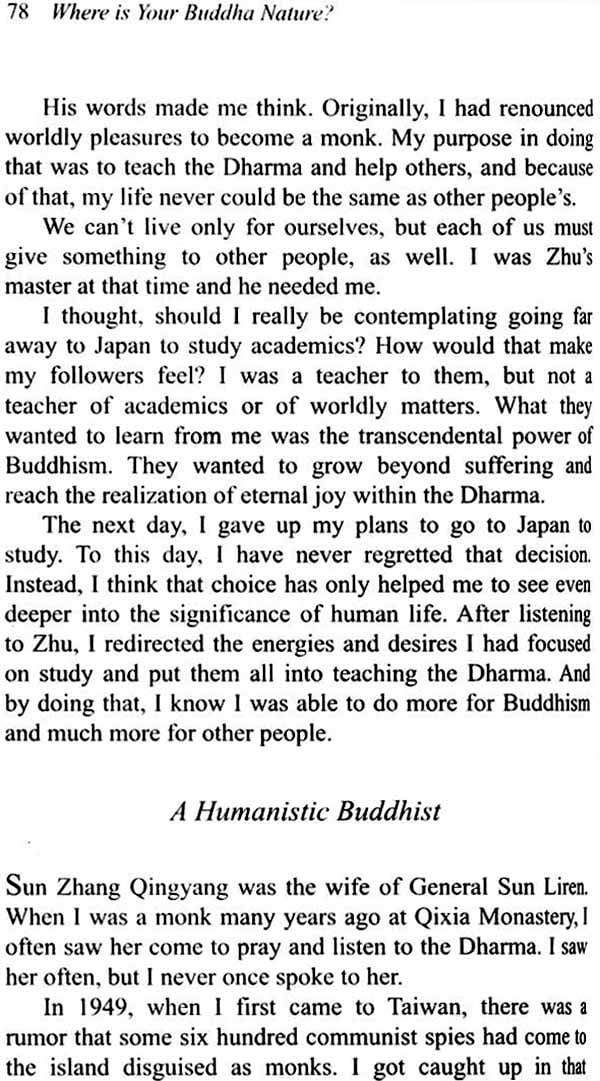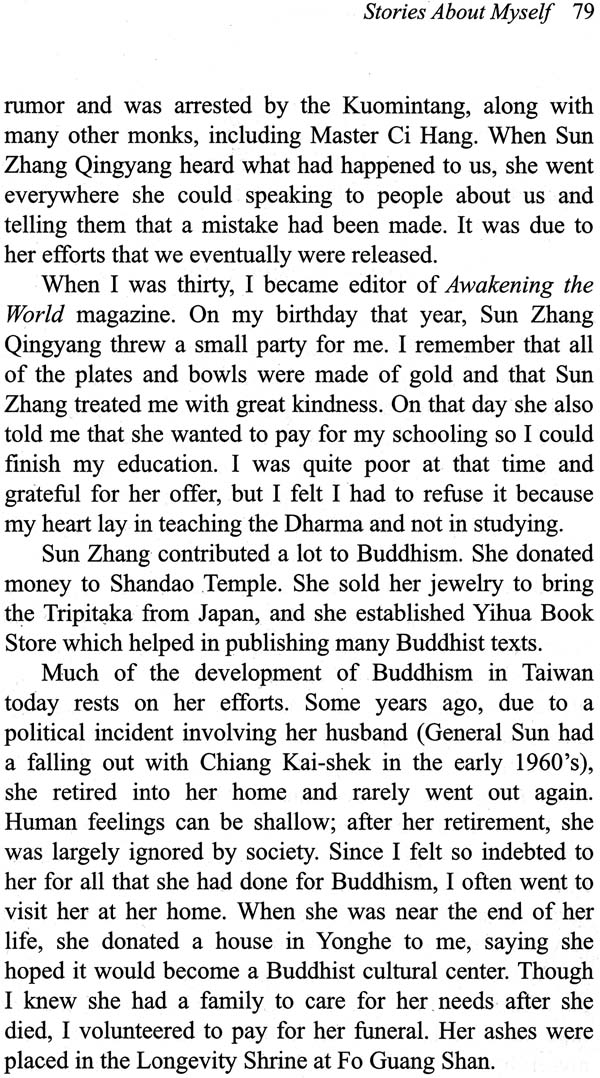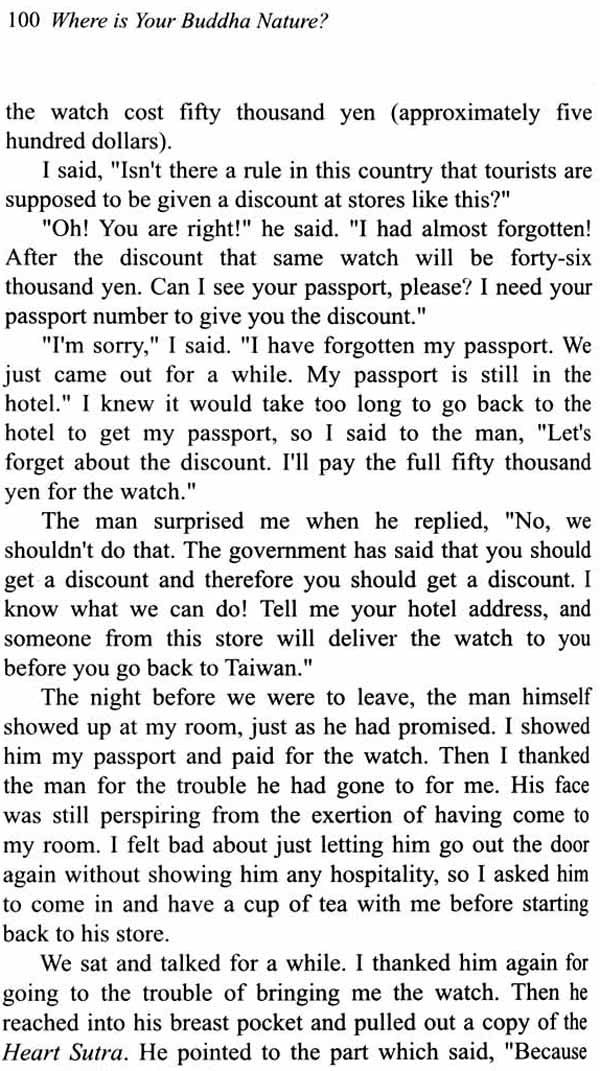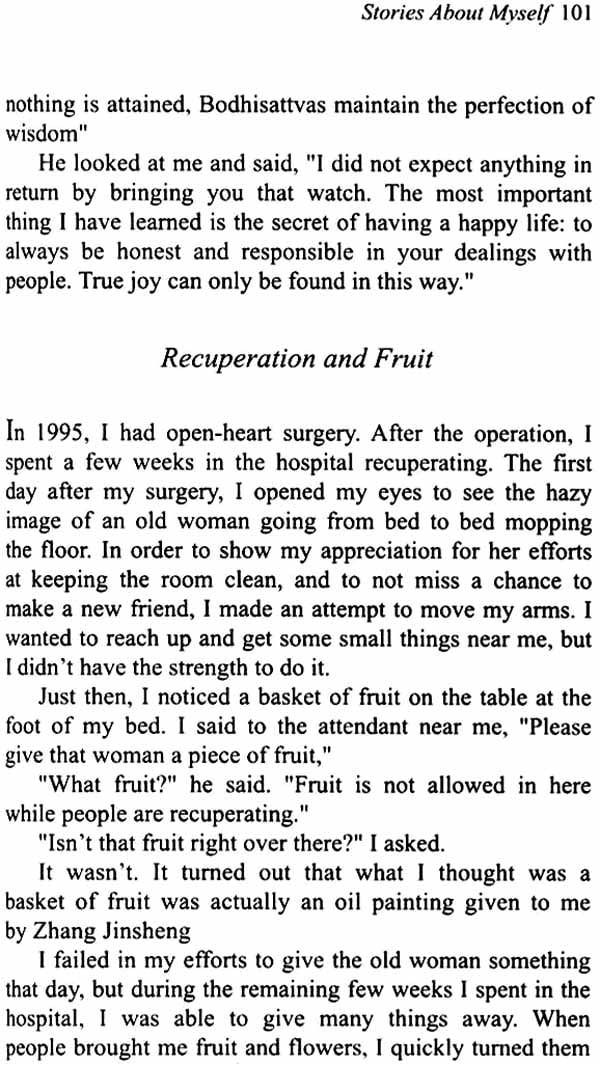
Where is Your Budhha Nature (Stories to Instruct and Inspire)
Book Specification
| Item Code: | NAP120 |
| Author: | Venerable Master Hsing Yun |
| Publisher: | Buddha Light Art and Living Pvt Ltd |
| Language: | English |
| Edition: | 2012 |
| ISBN: | 9789382017097 |
| Pages: | 192 (30 Color Illustrations) |
| Cover: | Paperback |
| Other Details | 8.5 inch X 5.5 inch |
| Weight | 230 gm |
Book Description
About The Book
Storytelling is one of the most ancient Buddhist traditions, and in fact many of the most revered Buddhist scriptures are collections of stories. Where is Your Buddha Nature? Is too: stories that teach, encourage, guide, inspire, and, not least of all, amuse. Gathered into eight groups-stories about the Buddha, about Chan master, about people, devotees, disciples, animals, monastics, and about Master Hsing Yun himself-they harken back to the earliest origins of Buddhism and at the same time are contemporary and immediate, filled with the hum of the modern world and the real situations, conflicts and opportunities Buddhists face within it. These accessible and appealing tales and anecdotes are also a perfect and painless introduction to modern Buddhist belief and practice.
About The Author
Venerable in Master Hsing Yun was born in Jiangdu, Jiangsu Province, China, in 1927. Tonsured under Venerable Master Zhikai at age twelve, he became a novice monk at Qixia Temple, a mountain monastery in Nanjing, China. After arriving in Taiwan in the spring of 1949, the Ven. Master became the chief editor of Life journal, Awakening the World, Buddhism Today, and a host of other publications. In 1952, while at Leiyin Temple in IIan, he established changting groups, student and youth organizations, a children’s Sunday school, and various Dharma teams that eventually laid the foundation for his future efforts in Buddhist propagation.
In 1957, the Ven. Master established a Buddhist cultural center that became today’s Cultural Enterprises Co., Ltd. that publishes a variety of Buddhist books and audio-visual training tools. The founding of Fo Guang Shan Buddhist Order in 1967 actualized the ven. Master’s vision of Humanistic Buddhist through education, cultural activities, charity, and religious practices that “foster talent, propagate the Dharma, provide aid, cultivate morality in people.” Since then, over one hundred and fifty branch temples have been established worldwide. Among them are His Lai Temple, Nan Tien Temple, and Nan Hua Temple, the largest Buddhist temples ever built in North America, Australia, and Africa, respectively. In addition to art museums, libraries, , publishing houses, and bookstores, the Ven. Master also established a free medical clinic, a Buddhist research institute, two high schools (Zhi Guang and Pu Men High Schools), His Lai University, now university of the West, in the United States, as well as Fo Guang University and Nan Hua University in Taiwan. In 1970, 1975, and 1987 respectively, Great Compassion Nursery, Fo Guang Senior Citizens Home, and the Compassion Foundation were Formed to provide for orphans, abandoned children, and senior citizens, as well as the poor and needy in Taiwan. Today, about two thousand monastic disciples have been tonsured under Ven. Master Hsing Yun who over a million followers worldwide. Throughout his life, the Ven. Master has dedicated himself to propagating the ideals of being a global citizen and developing Humanistic Buddhism in which the teachings of joy and harmony, integration and coexistence, respect and tolerance, equality and peace are widely disseminated. Upon the inception of Buddha’s Light International Association on February 3, 1991, Ven. Master Hsing Yun was elected to assume its presidency. As of 1997, over one hundred International chapters of the BLIA have been established to carry out the Ven. Master’s ideal of “letting the Buddha’s light shine over the three thousand realms and the Dharma water flow throughout the five continents.” Over the years, the Ven. Master has been recognized with numerous awards. In addition to the highly acclaimed honors received in his home country, the Republic of China, the Ven. Master has also gained international attention for his selfless dedication and contributions. He is the first person from the R.O.C. to be granted an honorary Ph.D. by the University of Oriental Studies in 1978, and was awarded the Buddhist Gem Award by the Indian National Buddhist Assembly in 1995. In May of 1997, Taiwan’s Ministry of Internal and Foreign Affairs honored him for his extraordinary contribution to society, his country, and Buddhism at large. In February of 1998, the Ven. Master hosted the Triple Platform Full Ordination Ceremony along with the Five Precept and Bodhisattva precept Ceremonies in Bodhgaya, India to restore the Theravada bhiksuni precepts, which had been lost for over a millennium. On April 8, 1998, he accepted the Buddha’s tooth relic which he personally escorted from India to Taiwan where it would remain. The Ven. Master’s contribution toward Buddhism is truly phenomenal, and has helped society gain a better understanding of Buddhism amidst current trends of institutionalization, modernization, humanism, and globalization. For more information about the life of Venerable Master Hsing Yun, please see Handing Down the Light and Bright star, Luminous Cloud by Fu Zhiying.
The best way to introduce a story teller is to tell a story about him. One day Master Hsing Yum was attending to the day’s business in a small conference room. A group of ochre-robed monks and nuns was helping him by recording his decisions and preparing them to be transmitted to the places. The monastic organization that Master Hsing Yum oversees is very large and nearly every decision he marks affects a lot of peoples. Needless to say, not everybody is always happy with everything he decides. Decisions, by their very nature, discourage some as they encourage others. At one point, when a particularly difficult judgment was called for, Master Hsing Yun raised his head to take in the room. When those in attendance saw him pause and look around, they drew near to him for they could see the deep concern in his eyes. At last he spoke,” Do you understand why the Buddha is revered by so many people?” His eyes indicated a statue of the Buddha set in a wall nearby. “Do you understand why he is worshiped in so many parts of the world?”
His question clearly called for no answer. The group looked first at the statue of the statue of the Buddha and then at Master Hsing Yun as they waited for him to continue.
“It is because he never speaks. He just sits there and never says anything to anyone.” As his small audience struggled to control its laughter, Master Hsing Yun continued, “And me?” he said, “All I ever do is talk and that’s why I have so many problems!”
Master Hsing Yun, whose name means “star cloud,” is a large man. He has the arms and chest of someone who was used to heavy labor when he was young. His head is closely shaved in the traditional style of a Chinese monk.
Though he has experienced health problems in recent years, his voice and manner are steady. His followers describe him as being boylike, for he carries himself with an innocence that seems to be remembered from a childhood spent in the countryside. Western Jiangsu, the part of China that he is from, is known for its poverty, its agricultural products, and its tradition of storytelling. People from that part of China are good speakers, distinguished by their pluck and their ability to be self-effacing when standing before large groups.
The story above was told to me someone who heard it from someone else. A few incidents I remember from my own experience show other sides of him. Once a small group of us was visiting the future site of His Lai University, now University of the West, near Los Angeles when we were accosted by a man who seemed to take great offense at our being where we were .The man shouted so loudly and carried on for so long that we were force to leave the room in which we had been sitting. As Master Hsing Yun walked past him, I watched to see what his reaction would be. As the angry man shouted at him just a few inches from his face, he showed no sign that anything was happening at all. He made no move to defend himself or to look at his antagonist. When we regrouped outside of the building, he made no mention of the incident. As we stood in the parking lot, his years of ascetic training were fully apparent, for he had managed to completely remove himself from the tension of his surroundings. While the rest of us glanced back at the man still shouting in the doorway, Master Hsing Yun seemed to have entered a silent and deeper part of his being.
On another occasion that I witnessed, he traveled for two hours to speak to an American disciple who had been disturbed by Al Gore fundraising incident that had taken place at the temple in Hacienda Heights. Master Hsing Yun explained what had happened, why it had happened, and apologized liberally for any misunderstanding that may have resulted from his actions. I thought that his humanity and humanity were impressive. The man who was disturbed by the incident, probably because he could not understand Chinese, continued to be disturbed by it and eventually left the temple, despite the master’s apology to him.
It is hard for Westerners, whom are so used to laws and abstractions, to achieve what Dostoyevsky called “infeeling” for the way of other societies, in this case the ways of a Chinese monastery. There are rules in the monastery, but the most important rule is always the master himself. His decisions and his actions determine the tone of everything that happens. In the secular sphere, this kind of system may lead to the abuse of the governed, but in the religious sphere, it more often leads to a massive burden being placed upon the shoulders of the one who governs. The head of monastery is called a “master” in English, a word that inspires fear and rebellion. Westerners always see the obeisance that is demanded of the student in this relationship, but they rarely see anything more. In Chinese, the master of a monastery is called “teacher-father.” While it is true that a “teacher-father” should be respected, it is also just as true that he must expend all of his energies on his disciples.
The stories in this collection will give readers a fascinating view into the mind of one of China’s great modern teacher-fathers. Some of these stories concern life in the monastery of events from Chinese history. Some of them are auto-biographical and some are concerned with the lives of his disciples. All of them are told with deep feeling.
In the autobiographical section we are given glimpses of his boyhood, his early years as a monk, and the hardship he endured he first arrive in Taiwan. We are also given many insights into the qualities that allowed him to build the largest Chinese monastery in the world today. Readers may be surprised to learn that his success is built much more upon kindness and concern for his followers than it is upon determination, though of course, there was much of that too. In his stories about his disciples, we learn how h thinks about his followers and how he understands his responsibilities towards them. In the stories about monastic and Chan masters, we see how other Buddhist monks and nuns have reacted to situations in their lives.
To my eye, the most interesting element in this collection is seeing how Master Hsing Yun thinks of others. Anthropologists call the “teacher-father” relationship a “fictive kin” relationship because it draws upon the primal energies of the family. This seems like a loaded term to me because it implies that there is something false about the relationship. It seems to say that we are fooling ourselves if we look elsewhere for love and security we ideally experienced in our families when we were children. In the West, this may be true, but who knows? While all of us have many teachers, few of us have teacher-fathers who really help us climb to new levels of achievement and self-awareness. We are even strained in English to come up with a word for people like that. We call them mentors after the name of Odysseus’ tutor, Mentor, or we call them coaches in a feeble attempt to expand sports into a metaphor for life. A teacher-father is someone who accepts us into the greater family of his mind. In the stories in this collection, we see this side of Master Hsing Yun, and we see it from many different angles. I believe that his perspective on his responsibilities for those who call him teacher-father makes for some very powerful reading, and I would ask readers to watch their own reactions as this aspect of his personality appears on the page. Who, besides your mother of father, thinks that way about you? And isn’t this how we all should be thinking about each other, as much as we can?
Incidentally, nuns are also called “ teacher-father” in Chinese, for this relationship is understood as being fully material as well as paternal. Indeed, the Buddha himself, who is the greatest teacher-father of all, is a manifestation of a transcendental reality that both includes and surpasses all gender distinctions, as well as all other conceivable opposites.
Though the essence of a good story lies in its drama and emotion, the Buddhist ideas of compassion and generosity play a very important role in this collection. It might be helpful to say something about them here. Buddhists use the word compassion rather than love because for them the word love traditionally cannoted what might be called “clinging love”. the kind that can make us jealous. The Buddha described compassion as meaning “what a mother feels for her child.” It connotes profound empathy and concern for other beings. It is based on a deep intuitive understanding that all living beings are one, and that what is good for one of them is good for all of them.
The word generosity also has different connotations in a Buddhist setting than it typically does in English. In a Buddhist context it means something more like ”profound sharing within the recognition that we are all Buddhas.”
Generosity is the basic urge to reach out to other and help them. The Buddha taught that there are three fundamental kinds of generosity: offering material gifts, offering the gift of the Dharma, and offering fearlessness. The purpose of each of these kinds of generosity is to free others from suffering and fear. The Buddha emphasized each of these kinds of generosity, for he knew very well what it feels like to be a conscious being with an impermanent body in a dangerous world.
In addition to the dynamic of the teacher-father relationship, readers will also find that the ideas of compassion and generosity inform nearly all of these stories on many different levels. They are central to all of Buddhism, as well as to the toil of teacher-father, whose primary goal is to attract people to the truth.
Master Hsing Yun is the forty-eight patriarch in the Linji (Rinzai) line of Chinese teacher-father. Master Linji (Rinzai) line of Chinese teacher-father. Master Linji (?-867) is famous for his apparently outrageous statement . He is the one who once yelled, “If Sakyamyni Buddha came around today and starting teaching the Drama, I’d beat him to death with a stick and feed his body to the dogs!” He also once said, “What use is the Tripitaka? Bring it here and I’II use it as a rag!” The Tripitaka is the officially recognized and (normally) revered collection of Buddhist sutras and commentaries. Master Linji ‘outrageous statements were not meant to offend us, but to open our minds to a world of truth that lies beyond reverence and beyond formal religious practice. If you can hear the compassion in his voice as it echoes through the centuries, you will have understood an essential part of Chan Buddhism. If you feel empowered and a little less afraid of your world because of his statements, you will have understood another part of that great tradition. The Chan lineage began when the Buddha handed a flower to Mahakasyapa . The flower signified that the core of the Buddha’s teachings had been successfully transmitted “mind to mind” to his disciple.
Master Hsing Yun oftern says that he is a Buddhist teacher-father and not a Chan one. He does this to overcome lingering division that still exist within the Buddhsit community, and probably also to distance himself a little from the eccentric image of Master Linji.
China is still a conservative society and projecting a wild image is simply not going to bring very many people into the temple. Master Hsing Yun has become a major force in the revitalization of modern Chinese Buddhism precisely because he has brought millions of people into the temple.
He has followers in nearly every country in the world. At the heart of his teaching is the explicit message of the importance of human life and the need for compassion in everything that we do.
I think there is also an implicit message delivered by Master Hsing Yun wherever he goes, and inspiration that has little to do with the words he speaks or writes. In the spirit of Chan this message must be received directly into the mind. Whenever I visit him I am as impressed by his wonderful sense of daring as I am by his compassion. The quality in him that people describe as innocent of boylike also seems to be ancient, something that has been handed down from one generation to the next during the twenty-five centuries that have intervened since the Buddha gave his flower to Mahakasyapa. The Buddha gave him the flower because Mahakasyapa had smiled at something the Buddha had said. I bet that Master Linji also gave something extraordinary to those of his disciples who laughed who laughed at his jokes. I know that Master Hsing Yun has something to give us, too. I hope that readers will find it in this collection.
Contents
| Introduction | xiii |
| Stories About the Buddha | |
| The Buddha's Sence of Equality | 1 |
| Sweep and Clean | 3 |
| Breaking the precepts to Save a Life | 5 |
| Two Alms Bowls | 6 |
| Two Robes | 7 |
| Carrying His Father 's Coffin | 8 |
| Caring for the Sick | 10 |
| Higher Love | 11 |
| Practice Is Like Tuning a String | 12 |
| A Representative | 14 |
| Stories About Chan Masters | |
| Getting to the Point | 17 |
| The Tears of a Master | 18 |
| Not for the Sake of Anger | 19 |
| Over the Wall | 21 |
| Borrowing from the Buddha | 22 |
| Master Ikkyu Suns His Sutra | 24 |
| I Have a Togue, Too! | 24 |
| The Master Becomes a Son-in-law | 25 |
| Stories About People | |
| A Neighbor's Love | 29 |
| A Father's Regrets, a Mother's Love | 31 |
| The Wild Crane Is Free to Soar | 33 |
| A Little Girl on a Bus | 34 |
| There Are Eyes in Heave | 35 |
| A successful Benefator | 37 |
| A Late Guest | 38 |
| Spiritual Weaponry | 39 |
| Fruit Faces | 40 |
| A Child's Love | 41 |
| Practice What You Preach | 43 |
| Where is Your Buddha Nature? | 44 |
| Stories About Devotees | |
| Behind the Scenes | 47 |
| Hello Teacher! | 48 |
| Fearlessness | 50 |
| Lotus Gesture | 51 |
| The Whole World is Yours | 52 |
| This Is My Home | 54 |
| One of the Buddha 's Workers | 55 |
| Loyalty | 56 |
| Inner Engines | 57 |
| Buddha's Light Tea | 58 |
| A Promise | 60 |
| Believing Versus Practicing Buddhism | 61 |
| Only Love Can Win Love | 62 |
| I Could't Watit Any Longer | 63 |
| Earning Joy | 64 |
| Stories About Myself | |
| Speechless Chicks | 67 |
| A Child's Heart | 68 |
| A Teacher's Heart | 69 |
| Sneaking Out at Night | 70 |
| Refugees at Qixia Monastery | 71 |
| A Half Bowl of Pickles | 72 |
| The Sangha Relief Unit | 73 |
| An Unorthodox Way to Help | 74 |
| Iniversal Gate | 75 |
| Giving Up My Studies | 77 |
| A Humanistic Buddhist | 78 |
| To See the Sun Again | 80 |
| A Tireless Worker | 81 |
| Helping a Helper | 83 |
| His Contribution | 84 |
| Paying Extra fro Shoes | 84 |
| Some Children Named Li | 85 |
| Adding Parents | 87 |
| A mouthful of Good Teeth | 88 |
| Standing In for the Buddha to Give Thanks | 89 |
| The Price of a Bowl of Noodles | 90 |
| Taking Refuge Over the Phone | 91 |
| Leave No One Behind | 92 |
| Kitchen Work | 93 |
| The Price of Master's Calligraphy | 95 |
| A Little Dandelion | 96 |
| Kindness | 97 |
| A Thirty Year Wait | 98 |
| Buying a Watch | 99 |
| Recuperation and Fruit | 101 |
| I See All of You | 102 |
| A Resolution for 2/28 | 103 |
| Stories About Disciples | |
| Little Novices Sleeping | 105 |
| A Good Method | 106 |
| Ice Capades | 107 |
| Nylon Stockings | 108 |
| Turning Weapons into Jade and Silk | 109 |
| Sympathy | 111 |
| Wind and Rain Increased His Faith | 112 |
| An Uninvited Friend | 113 |
| Li Ku | 113 |
| Friendship Based ona a Book | 115 |
| A Thirty Year Promise | 116 |
| They Came for the Dharma | 117 |
| A Loving and Respectful Disciple | 118 |
| Sories About Animals | |
| If It Hadn't Been for the Dog | 121 |
| Raising a Monkey | 122 |
| People Are Slow Learners | 123 |
| Traffic Stop | 125 |
| Returning to Nature | 126 |
| Adding Color | 128 |
| Man Di Runs Away | 129 |
| Living with a Snake | 131 |
| Bl;ack Tiger | 132 |
| Stories About Monastics | |
| The Car | 135 |
| Looking for a Home Outside of Home | 136 |
| Strength and Faith | 137 |
| Lending Money | 138 |
| Two Nuns and Their Little Guest | 139 |
| A Nun's Heart | 141 |
| A Thief in the Chan Hall | 142 |
| The Pure Land | 144 |
| Giving Others Joy | 145 |
| I'II Take That on Myself | 146 |
| My Father | 147 |
| You're the Only One | 148 |
| Planting Seeds for Her Son | 149 |
| Lost in Tibet | 151 |
| Brotherhood | 152 |
| Deserving Their Frame | 153 |
| Warmth and Kindness in Another Land | 154 |
| Glossary | 159 |
| Afterword | 165 |
